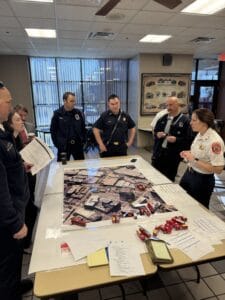A structural collapse can quickly evolve into a complex response that necessitates specially trained personnel, specific and technical equipment, and support from neighboring departments and regional assets. The nature of these unique situations warrants in-depth planning and training to adequately prepare fire department resources. To assess the structural collapse capabilities of the Montgomery County Fire & Rescue Service (MCFRS) and Prince George’s County Fire/EMS Department (PGFD), and as part of a larger evaluation, the Maryland-National Capital Region Emergency Response System (MDERS) hosted two tabletop exercises (TTXs) in early March. The exercises were effective in assessing both departments’ ability to communicate, coordinate resources and personnel, and implement response strategies.
The Occupational Safety and Health Administration (OSHA) has defined a structural collapse event: “when internal load bearing structural elements fail, a building will collapse into itself and exterior walls are pulled into the falling structure” (Occupational Safety and Health Administration, n.d.). Natural or man-made actions can cause these incidents and vary in scope, severity, and potential operational duration (OSHA, n.d.).
Both MCFRS and PGFD maintain an internal capability to respond to incidents involving structural collapse. Most commonly, both departments deploy these resources for minor incidents like a vehicle inadvertently crashing into a building, which causes minimal damage. However, MCFRS and PGFD can integrate with local, regional, and federal resources during large-scale incidents.
Prominent events can also often be the catalyst for internal review of a department’s capabilities. In the aftermath of the 2021 Surfside collapse, MCFRS and PGFD began a process with MDERS to evaluate and enhance each department’s existing structural collapse capability. These three entities followed the POETEE (planning, organizing, equipping, training, exercising, and evaluating) model to have a streamlined framework for departmental improvements. Adhering to this meticulous approach has produced measurable achievements for both departments with more training for personnel, and the acquisition of specialized equipment such as Paratech Guardian Systems, Bluetooth listening devices, and most notably a technical rescue trailer for MCFRS.
As part of the POETEE model, MDERS, MCFRS, and PGFD have recently been coordinating exercises to gauge the current status of each department’s structural collapse capability. The first phase of the exercise portion was two TTXs. The goals for these TTXs were to:
- Evaluate the ability of MCFRS and PGFD to cohesively integrate personnel and equipment into a unified response to a structural collapse incident.
- Assess each department’s command structures’ ability to manage the initial response and transfer oversight to special operations.
- Examine each department’s procedures for establishing a unified command, coordinating resources, and delegating tasks to the appropriate personnel and entities to ensure seamless incident management.
- Determine if each department has the needed trained personnel and specialized equipment to effectively respond to a structural collapse incident.
Two scenarios, one in Montgomery County and one in Prince George’s County, were devised to test each department’s ability to effectively manage and respond to a large structural collapse incident. A battalion chief from each department spearheaded the response, coordinating with specialized personnel. The exercise strained participants to identify, parse, delegate, and overcome the litany of tasks associated with these complex responses. The TTXs were well received by the participants and yielded areas for further discussion.
These TTXs were engineered to focus on command-level decision making, but the next exercise as part of this process will be a two-day full-scale exercise with participants from MCFRS and PGFD. This larger exercise allows aspects from the TTXs to be implemented and assess the technical skills of each department.
Source
OSHA. (n.d.). Structural Collapse Guide. Retrieved September 22, 2024, https://www.osha.gov/emergency-preparedness/guides/structural-collapse



